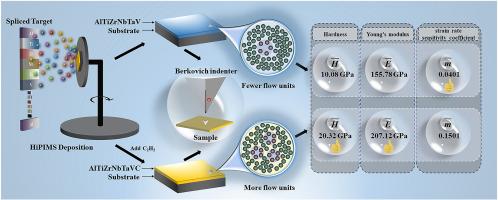HiPIMS高能离子束制备AlTiZrNbTaV(C)高熵金属玻璃薄膜的纳米力学性能
IF 4.8
2区 材料科学
Q2 CHEMISTRY, PHYSICAL
引用次数: 0
摘要
工程高熵金属玻璃(he - mg)经常面临硬度和抗蠕变之间的权衡,这限制了结构的部署。这项工作证明了间隙碳掺杂如何在AlTiZrNbTaV系统中解耦这些性质。碳掺杂使AlTiZrNbTaVC的硬度提高了101.60%,达到20.32 GPa,但却降低了其抗蠕变性能。AlTiZrNbTaVC的应变速率灵敏度(m)增加了三倍以上,从AlTiZrNbTaV的0.0401增加到AlTiZrNbTaVC的0.1501。弛豫时间谱分析表明,这种退化源于剪切转变区(STZs)较低的活化能垒。这些结果表明,stz的活化能,而不是自由体积,是控制该体系室温蠕变的主要因素。这为通过调整he - mg的原子尺度非均质性来实现硬度和稳定性之间的目标平衡提供了一个明确的策略。本文章由计算机程序翻译,如有差异,请以英文原文为准。

Nanomechanical properties of AlTiZrNbTaV(C) high-entropy metallic glass films prepared by HiPIMS energetic ion beam
Engineering high-entropy metallic glasses (HE-MGs) often faces a trade-off between hardness and creep resistance, which limits structural deployment. This work demonstrates how interstitial carbon doping can decouple these properties in an AlTiZrNbTaV system. While carbon doping increased the hardness of AlTiZrNbTaVC by 101.60 % to 20.32 GPa, it paradoxically degraded creep resistance. As the strain rate sensitivity (m) of AlTiZrNbTaVC increased more than threefold, from 0.0401 for AlTiZrNbTaV to 0.1501 for AlTiZrNbTaVC. Relaxation time spectrum analysis reveals this degradation stems from lower activation energy barriers for shear transformation zones (STZs). These results establish that the activation energy of STZs, rather than free volume, is the dominant factor controlling room temperature creep in this system. This provides a clear strategy for tailoring HE-MGs by tuning their atomic-scale heterogeneity to achieve a targeted balance between hardness and stability.
求助全文
通过发布文献求助,成功后即可免费获取论文全文。
去求助
来源期刊

Intermetallics
工程技术-材料科学:综合
CiteScore
7.80
自引率
9.10%
发文量
291
审稿时长
37 days
期刊介绍:
This journal is a platform for publishing innovative research and overviews for advancing our understanding of the structure, property, and functionality of complex metallic alloys, including intermetallics, metallic glasses, and high entropy alloys.
The journal reports the science and engineering of metallic materials in the following aspects:
Theories and experiments which address the relationship between property and structure in all length scales.
Physical modeling and numerical simulations which provide a comprehensive understanding of experimental observations.
Stimulated methodologies to characterize the structure and chemistry of materials that correlate the properties.
Technological applications resulting from the understanding of property-structure relationship in materials.
Novel and cutting-edge results warranting rapid communication.
The journal also publishes special issues on selected topics and overviews by invitation only.
 求助内容:
求助内容: 应助结果提醒方式:
应助结果提醒方式:


